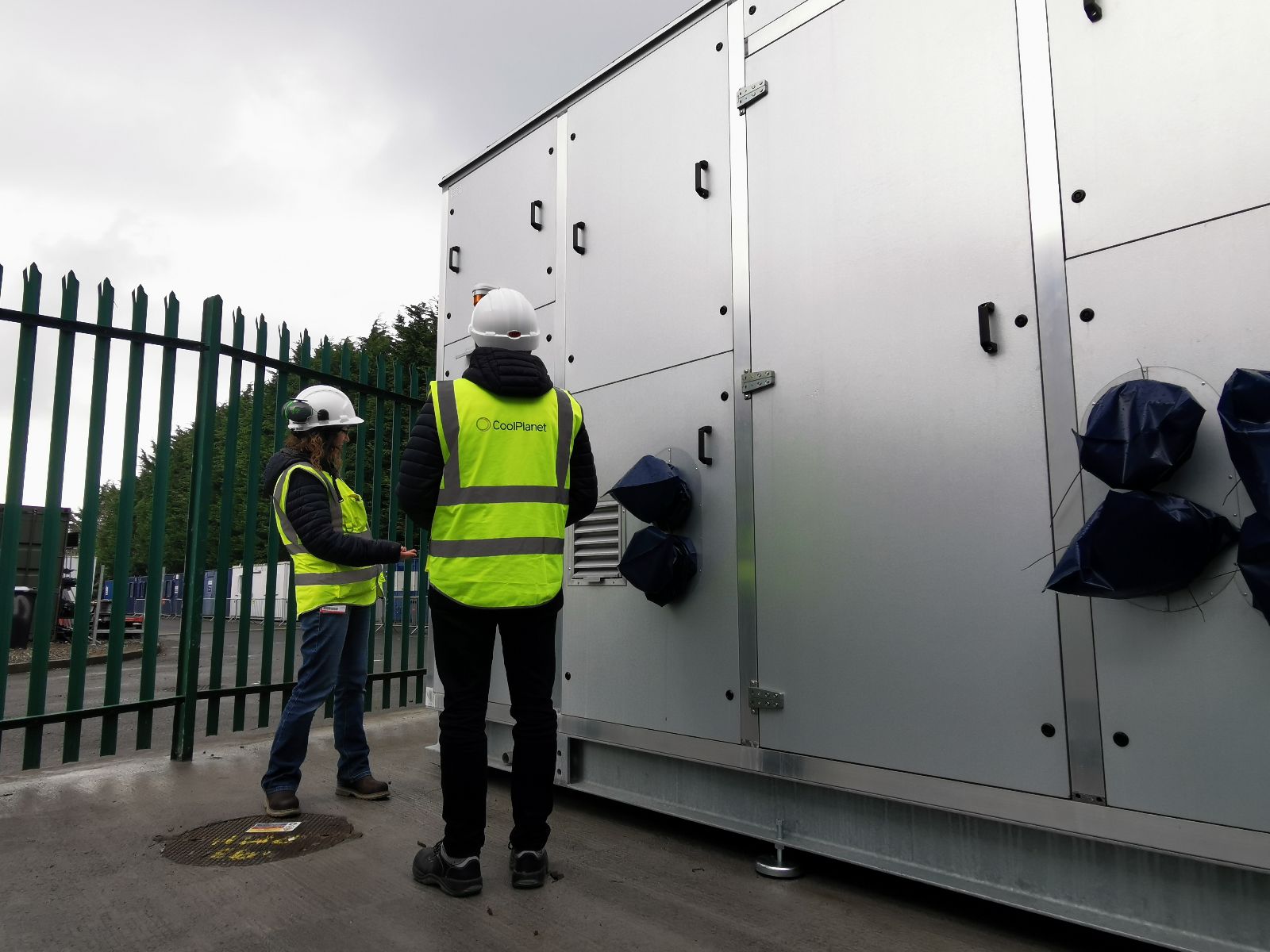Is it weird if we wax poetic about heat pumps?
Heat pumps are the unsung heroes of transferring heat. They’re one of the most efficient ways to warm our homes, cool our buildings, and power important factory processes.
But heat pumps have been the ugly step-sibling for decades. Even 75 years ago, British author J Gordon Cook wrote, “It seems incredible that a device such as the heat pump should have escaped the attention it deserves.”
Boilers and furnaces have long been seen as the standard for generating heat, but heat pumps do the same job more efficiently. They don’t use fossil fuels to generate heat — they transfer waste heat instead.
And where boilers are a somewhat stagnant technology, a heat pump’s design can be refined and engineered to get even more performance from it in your factories.
So yeah, this nearly two-century-old tech could be the very thing that solves a lot of our emissions issues.
Factories need heat — lots of it
Heat is a central part of many factory operations — even if the end product is cold meat, milk, or beer. But not just any temperature will do. The heat that’s applied to industrial processes is fittingly called “process heat”, and it needs to get pretty hot in there to work.
Process heat is used to transfer energy from a heat source to a material or product in order to alter it, shape it, or make it safe for people to use or consume. Traditionally, it’s produced by burning gas or oil to raise temperatures to a minimum of 80℃ (176℉) — but sometimes, process heat is needed for temperatures up to 1000℃ (1832℉).
Milk pasteurisation is one example of an industrial process that uses process heat. Using a boiler, the system heats up and maintains temperatures to about 80℃ — hot enough to kill harmful bacteria. The milk passes through a heat exchanger for pasteurisation before being strained and bottled.
Breweries also use a lot of hot water and heating to make beer. They need to heat the mash (a mixture of grain and hot water) and boil it with hops.
In some factories, process heat also needs to be hot enough to produce steam. In our brewery example, the kettle needs to fire hot enough to create steam for boiling. In the edible oils industry, some applications require direct steam to impinge upon the product.
Fossil fuels used to be the primary way to generate heat at scale
One thing about process heat: it’s responsible for a large proportion of energy usage and greenhouse gas emissions (GHG) inside factories. That’s because, for most of history, we’ve relied on fossil fuels to generate it.
The traditional configuration for generating process heat inside a factory is a boiler system, which runs on fossil fuels like gas or coal. You can see a visual of this setup in the diagram below.
But why is this such an issue? Because using boilers to generate heat is energy-intensive. Over 50% of the energy used onsite in manufacturing is for process heat, according to the U.S. Office of Energy Efficiency and Renewable Energy.
That energy isn’t clean. It significantly drives up a factory’s Scope 1 emissions to constantly burn gas, oil, or even coal.
It also drives up costs. You have to pay for the price of fuel to power your boilers, and they’re not a very efficient heat source. In energy terms, efficiency is measured as a coefficient of performance (COP). And boilers have a maximum COP of 95%. That means they lose 5% of energy in the process of converting fossil fuels to heat — and that’s before that energy even leaves the boiler.
These problems increase when you need to reach higher temperatures for steam generation, such as for running the kettle in a brewery. Other processes might require temperatures of 80℃ or 90℃ to generate hot water. But to generate steam for the kettle, you need to reach temperatures of at least 100℃. In those cases, you’re burning even more gas to get up to — and maintain — a higher grade temperature.
But we figured out an alternative over 160 years ago
Fossil fuels and boiler systems aren’t the only way to generate heat, though. Enter the heat pump: a relatively simple invention developed in 1856 by Czech scientist Peter von Rittinger to dry out salt marshes two centuries ago.
The invention was a closed steam vessel that used a mechanical compressor to increase the temperature and pressure of water vapour in order to heat up the brine. The end result: salt would precipitate out, and water would collect inside the vessel.
Heat pumps were also used throughout history for industrial refrigeration. Compressors were in use in industrial applications like breweries and meatpacking factories as early as the 1870s. The first electrically driven ground source heat pump was proposed in 1912 for the production of low-temperature heat, but it was never applied.
Many historical applications of the heat pump, though, involved heating buildings. The heat pump would circulate hot water or heat and then transfer that heat throughout the building. Despite their effectiveness here, heat pumps weren’t widely adopted because of the cheapness and availability of fossil fuels.
Finally, oil prices exploded following the OPEC oil crisis, which led to more adoption of heat pumps, mainly in homes and buildings. And while they’ve yet to be applied in factories at such a large scale, they could be employed quite easily.
So how do heat pumps work, exactly?
Unlike boilers, which burn through fossil fuels to generate process heat, heat pumps can harvest what’s known as “waste heat” from other factory processes. Heat pump design relies on the concept of heat transfer, making it a much more efficient piece of technology.
Essentially, a heat pump moves heat from one environment or space to another rather than generating heat from scratch (or from a source like oil or gas). But how? Inside a heat pump, a refrigerant such as water flows around. The refrigerant absorbs warmth from a source and transfers it.
There’s also a compressor, which forces the refrigerant to higher pressures. That pressure change raises the temperature to an even higher point — a temperature that’s actually useful for heating a building or pasteurising milk.
In a factory, heat pumps can absorb waste heat or wastewater, compress it up to a usable temperature, and transfer it back into their industrial process flow as process heat. There are plenty of machines in a factory that are already giving off heat; heat pumps can recover it to keep consumption low and efficiency high.
Because they’re harvesting waste heat and re-injecting it back into factory processes, heat pumps have a much higher COP than boilers. For every kWh of energy a heat pump uses, it produces at least three units of heat — that’s a minimum COP of 300%. The International Energy Agency estimates that they are three to five times more efficient than gas boilers.
Across manufacturing, industrial heat pumps can save between 26-32% in source energy — a substantial reduction, especially if they’re replacing expensive fossil fuels. One project found that industrial heat pumps in electric drying can provide energy savings of 80%. That’s on top of cutting production costs by 20% and slashing carbon emissions by 80%.
Now, we’re bringing this 200-year-old tech into the 2020s
Only recently, heat pumps have become the “tech of choice” to install inside homes and buildings for heating and cooling while drastically reducing emissions. Now, demand is at an all-time high in factories, too.
Pound for pound, the heat pump already beats the boiler when it comes to efficiency — and that’s why folks are finally starting to take notice. However scientists and engineers are constantly working to raise the heat pump’s COP even further, which will help lower energy costs and make factory operations more efficient.
One scientist, Zhibin Yu, is working on a “prototype of a heat pump that stores leftover heat in a small water tank.” His design captures the waste heat that the heat pump itself generates, boosting its performance.
Yu’s novel design “could improve the COP by between 3 and 10%, while costing less than existing heat pump designs with comparable functionality.”
In a factory setting, the number-one challenge with implementing heat pumps to displace fossil fuels is reaching higher temperatures for steam generation. Typically, heat pumps have been used to generate hot water for industrial processes, reaching temperatures around 80°C or 90°C.
Water is usually the refrigerant in a closed-loop system. But with a different design — an open cycle configuration — it’s possible to produce high-pressure steam from low-pressure steam or condensate. The high-pressure steam can then be transferred back into industrial processes — think of the kettle in a brewery, for instance, or manufacturing edible oils, which requires direct steam.
Today’s heat pumps can reach higher-grade temperatures, and they’re much more efficient. But the real engineering feat? They’re now capable of producing carbon-free steam. And this technology is already available at an industrial scale.
Heat pumps give us a viable, tested solution for solving climate change
We don’t have another 200 years to solve climate change, but we don’t need time or even more technology — we just need to implement the tech we have.
Thanks to the invention of the heat pump and all the iterations and discoveries made to improve it, we have the tools we need right now to address the climate emergency. It’s already proven to transfer heat and reach process-grade temperatures at scale.
So what’s the holdup? Because configuring your factory to run on waste heat from a heat pump can take a lot of work and technical prowess, there’s much to consider from a design perspective. You’ll have to implement new machinery and reconfigure some workflows to identify peak performance.
But the good news is that engineering teams are built for challenges exactly like this.
They problem-solve for you every day, and they can work to integrate heat pump technology to reduce your emissions. While collectively, the climate crisis is our biggest challenge, we can tackle it one design challenge at a time.






